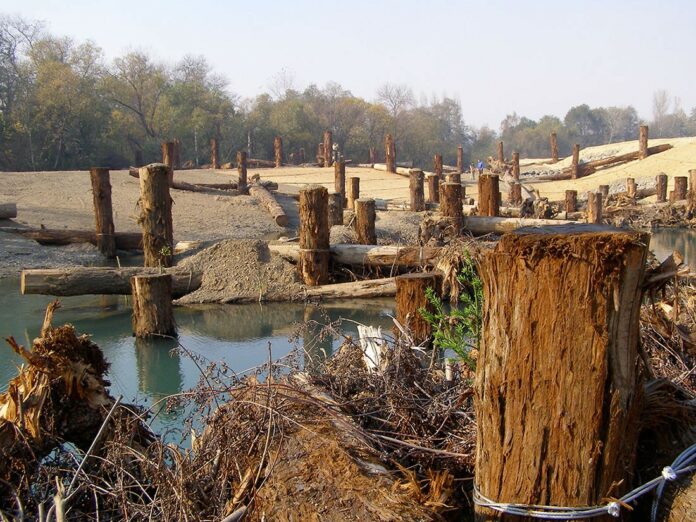In Dry Creek Valley, there’s at least one place where a jumble of felled trees doesn’t spell trouble for coho habitat. It’s part of a multimillion dollar project meant to restore Dry Creek’s salmon population—and possibly save the Sonoma County Water Agency an additional $150 million bill.
On Friday, Nov. 22, representatives from four government agencies, the Dry Creek Rancheria Band of Pomo Indians and members of the press gathered by a slow-moving channel just downstream from Warm Springs Dam to witness the release of 2,000 juvenile coho as part of the six-mile Dry Creek Habitat Enhancement Demonstration Project. Dressed in fatigues, U.S. Army Corp of Engineers district commander
Lt. Col. John Baker carefully lowered the first aquarium net full of small, wriggling fish to their uncertain fate.
The impetus behind the effort is a 2008 opinion issued by the National Marine Fisheries Service (NMFS). By 2004, the coho population in the Russian River system had declined to the point where little more than a dozen individuals could be counted. A crash program at the Don Clausen Fish Hatchery at Lake Sonoma has successfully reared coho salmon that return to the hatchery, but that’s just a start. “We want to restart the populations in historic coho salmon streams,” says Derek Acomb, an environmental scientist with the California Department of Fish and Wildlife. “We don’t want the fish to stray back to the hatchery.”
A few miles farther downstream, behind Amista Vineyards, the project’s ambitious scale may be viewed at a site just completed last month. Right now, the scene is weird and raw. A four-acre amphitheater was scooped out of the bank, draped with nets and spiked with a thousand sprigs. The scene is punctuated by 20-foot redwood stumps driven into the ground, cut clean at the top, rising out of a murky backwater.
If there’s something familiar here, it may be because many of these redwoods were cut down for the Highway 101 widening project near Airport Boulevard in Santa Rosa, and, in a move profitable for Ghilotti Construction, sold back to Sonoma County Water Agency for $98,000. Others came from a sustainable timber operation in Gualala, according to David Manning, SCWA environmental resources coordinator. Working with property owners like Amista’s Mike and Vicky Farrow, Manning secured long-term easements crucial to the project.
It may be surprising to learn that the trouble with Dry Creek, from the coho’s point of view, is that there’s too much water—especially in the summer. As the Bohemian has reported in recent years, vineyard frost protection draws and irrigation wells have compromised water levels in some of the watershed’s tributaries. But because of the constant summer flow released from the dam for the benefit of water customers, the creek is turning into a flume that limits the kinds of meandering channels that provide habitat for salmon. Paradoxically, cold water stored by the same dam will also benefit the salmon reared in this constructed pond, which is seven feet deep and studded with boulders tied to the redwood snags with steel cables. By next summer, willow trees planted along the banks—already sprouting—will begin to shade the water.
There is a plan B. The water agency and its partners have until 2020 to restore the coho to the satisfaction of the NMFS, which has the last word. The alternative calls for digging up Dry Creek Road and burying a pipeline bypass to route excess water all the way around the creek, at an estimated $150 million price tag.
With all that’s at stake, the four-inch fish aren’t being sent off with only a hope and a prayer. Since it was reinstituted, the hatchery’s program has benefited from genetic advances. Each coho female, according to Acomb, is matched to a list of breeding males ranked in order of preference. Each fish released has a small, staple-sized insert just above the nose, which can be identified with a microscope after dissection, if it’s later caught by fishermen.
An additional percentage are outfitted with passive integrated transponders, similar to the chips embedded in pet cats and dogs. These will be read by antennae as the fish check out of their quiet backwater for the long journey to the ocean. If they manage to return home after five years, they’ll be checked back in just like widgets in a modern warehouse.











